
The leader in
news and information on
low energy nuclear reactions
September 10, 2007 -- Issue #24
Copyright 2007 New Energy Times (tm)
Published by the New Energy Institute Inc. six times per year
Staff
Editor and Publisher: Steven B. Krivit
Copy Editor: Cindy Goldstein
Web Editor: Sally Robertson
Science Advisers:
Edmund Storms
John Armstrong
Support Team
Randy Souther
H.P.
Nick Palmer
V.F.
Contributors
----
New Energy Times (tm)
369-B Third Street, #556
San Rafael, CA 94901
(310) 470-8189
|
New Energy Times (tm) is a project of New Energy Institute, an independent 501(c)(3) nonprofit corporation that provides information and educational services to help bring about the clean-energy revolution.
|
__________________________________________________________________________________
New Energy Institute gratefully acknowledges the generosity and support of:
The New York Community Trust
__________________________________________________________________________________
EDITORIALS AND OPINION
1. From the Editor: The Emerging Champions
2. To the Editor
NEWS & ANNOUNCEMENTS
3. 8th International Workshop on Anomalies in Hydrogen- and Deuterium-Loaded Metals
ANALYSIS AND PERSPECTIVES
4. ICCF-13 Report
5. Excess Heat Report from Jean-Paul Biberian and Nicolas Armanet
6. Global Energy Outlook and the Realities of Greentech
7. SCIENCE AND ENERGY NEWS
8. The Wizard of Half Moon Bay: A New Energy Times Special Report on Planktos and D2Fusion
__________________________________________________________________________________
“The whole point of scientific research is that it is based on integrity and trust. The reason that science is able to work this way is because a scientist's personal integrity counts for an enormous amount.”
— Dr Ritu Dhand, Nature |
__________________________________________________________________________________
EDITORIALS AND OPINION
1. Editorial: The Emerging Champions
By Steven Krivit
 Photo: Daniel Bosler
Photo: Daniel Bosler |
Many people who look into low energy nuclear reaction research recognize that real science, real scientists, and quite possibly real energy exist in the field. Invariably, they ask me, "So what is the big problem holding back the science and, along with that, the possible commercial technology?"
I explain to them that the underlying resistance to the radical idea of low energy nuclear reactions is not a technical problem but a human problem, and that problem is fear. |
Many science authorities and research managers are terrified of the prevailing stigma of this subject, which once, through little fault of its own, disgraced the hallowed halls of academic science.
A Stanford Nobel-prize winner, per my request, sat in on one of my talks in 2005 and heard me explain the misunderstanding in 1989 that "cold fusion" was a mistake, a fraud and a delusion and was driven by faulty scientific analyses and shoddy experiments. The Nobel laureate declined to discuss the subject with me after my presentation. I found his silence perplexing.
Charles Beaudette has provided the most lucid explanation I have seen for such behavior. He describes it in "Excess Heat & Why Cold Fusion Research Prevailed" in a short section called "Fear Within the Institution."
In short, Beaudette explains, when some science authorities with prestige or recognition realize that a mistake has been made in the premature dismissal of "cold fusion," they instantly recognize their predicament. If they go to their peers and share with them their insight about the reality of LENR, they face potential hostility and mockery, perhaps not unlike the heretics hundreds of years ago did when they said that the earth was not flat.
The facts of LENR are known by numerous people in positions of power and authority in the scientific world. Despite this, many of them remain silent even though they have the capacity to influence and lead important research.
Some of them know of the evidence for excess heat, or of a theory that adds up, or the detection of nuclear particles that are otherwise-inexplicable. Yet they are terrified to go public and admit the reality of "cold fusion." This is, regrettably, understandable but not helpful.
The editors of some major journals continue to impede the progress of this field, also with no apparent explanation for their behavior but fear and their own sense of self-preservation.
In 2006, an abstract for a manuscript was presented by a U.S. government research team to Nature, and editor Karen Southwell dismissed it out of hand, with no explanation, and refused to send it out to peer review.
“I can only speak for Nature," Southwell wrote, "and we wouldn't want it.”
That's all she said. No further explanation.
Another strange event occurred earlier this year when ChemPhysChem editor Evelyn Wessel sent to 10 referees a manuscript which reported a nuclear reaction from a chemical experiment. Wessel responded to the authors that "only one of them was prepared to review your paper; the others declined or did not respond at all."
The one referee who responded wrote that the paper was very important and appropriate, and the referee recommended acceptance with minor alterations.
"We therefore come to the conclusion," Wessel wrote, "that your paper is too specialized for the broad and heterogeneous readership of ChemPhysChem."
In case it is not obvious to the lay reader, the hypothesis of obtaining nuclear reactions from chemistry is not indicative of a narrow effect; it is quite the opposite. The significance of LENR is so large that it stands to overturn aspects of scientific understanding going back hundreds of years. Don't look now, but there is an elephant in the middle of the room.
A second reviewer's report came to Wessel after she had sent the rejection letter to the authors.
"The authors present evidence for nuclear events that occur during the co-deposition of Pd/D," the reviewer wrote. "The experiments seem to have been conducted quite carefully, and the evidence seems convincing - as far as I can tell - even though the origin of these events is mysterious.
"The article can be published as is, but not in ChemPhysChem. I would consider the results as an interesting curiosity which is not of general interest."
A novel scientific effect, one that may lead to a new source of energy, is considered not of general interest to the ChemPhysChem editor and reviewer. Did they not understand the potential significance of the work? I highly doubt it. Did they sincerely believe that the subject would not be of general interest to their readership? That, too, I highly doubt.
The reviewer's comment "even though the origin of these events is mysterious" suggests that the reviewer has lost all sight of and is oblivious to the fundamental nature of new science. Science exploration is supposed to reveal new mysteries of the universe; it should be celebrated!
These science authorities more likely have either lost sight of a key aspect of their responsibilities or do not want to be on the leading edge of the new consensus that recognizes the validity of LENR and admits that discoverers Martin Fleischmann and Stanley Pons were indeed correct about their excess heat claims. Such recognition invariably would bring the shame and embarrassment on the part of the science establishment for its part in this ugly episode of science history.
In 2003, James Corey, now retired from Sandia National Laboratories, predicted that "an overdue revolution in science will arrive, and the reputations of cold fusion scientists and those who revile them may be reversed." Everything I have seen in the last four years indicates that Corey's prediction is proceeding on track.
Bob Park, a former arch-enemy of "cold fusion," apparently sees the writing on the wall and has been changing his tune slowly over the last several years, seeking an exit plan.
Park has gone from calling "cold fusion" "Voodoo Science" in 2000, to being quoted by Nature in 2004 as saying, "Although the quality of research has improved, no one should buy into cold fusion just yet;" by NPR in 2005 saying, "I've never seen anything quite like cold fusion. It's an interesting phenomenon. ... I guess I'm still skeptical," by Chemical & Engineering News in 2007 saying that the results "look interesting," and he is rumored to have said in a secret government meeting that he now concedes that there is "real physics" in the field of LENR.
Yet Park has declined to respond to my e-mail and phone call to discuss his new perspective on LENR.
He and the other perpetrators of the attacks on Fleischmann and Pons remain highly respected members of the science community. Another former attacker is Richard Garwin, a senior researcher at IBM and a nuclear weapons advisor to the federal government. I cornered him at a science conference last year and asked him whether he had looked at the Widom-Larsen theory. He said he had. I asked him whether he had found anything wrong with it. He said he hadn't. He grumbled that Widom and Larsen didn't reveal all of their details - regarding gamma sheilding - to him.
Garwin is a man who in the past has gone so far as to suggest that LENR researchers are mentally ill, as well as to deny his own secret, positive "cold fusion" confirmation when I uncovered it a few years ago.
People like Park and Garwin, who were quick to defame Fleischmann and Pons and deride their work, are not eager to endure the public embarrassment of their past poor behavior. People don't like to eat their hat or dine on crow.
Park, Garwin, and others are beginning to change course from their previous obstruction and delay of an important new science, and this is welcome and beneficial. Yet their initial actions and reactions to "cold fusion" will serve as a lesson for future science explorations and explorers.
New controversial science is not easy to consider, and risking one's reputation to support it is not easy. But a few courageous men and women in positions of power and influence are beginning to see the opportunities for leadership in LENR research.
Retired Gen. Lawrence Farrell is one such individual. After reviewing the research reported by the Navy's San Diego SPAWAR group, Farrell courageously took a stand in support of further exploration of LENR and welcomed the Navy's research into the National Defense Industrial Association science conferences.
Courageous journalists such as Newsweek's Sharon Begley and Michael Lemonick, the author of the 1989 Time cover story on cold fusion, have begun to recognize that the degrading labels previously assigned to "cold fusion" may have been wrong.
Tatiana Czeschlik, the editor of Germany's prestigious science journal Naturwissenschaften, should be commended, as should the editor and author of a recent Wired article for publishing and reporting the facts.
Other champions also will emerge. They will be people with the confidence to think for themselves, who posses the integrity to endorse legitimate but controversial science, and who have sufficient wisdom and insight to see pathways to solutions. They will share the leadership of this scientific and human challenge, they will emerge victorious, and they will make history.
__________________________________________________________________________________
2. To the Editor
To the editor:
I've enjoyed reading your recent issue, and because of my familiarity with calorimetry issues and the personalities who contributed to the much-needed exchange you published on the work of Scott Little and Earthtech, this warranted special attention from me. At some time in the past, Michael McKubre warned that those who pursued LENR experimentation without sufficient background (I think he said Ph.D. in electrochemistry) were wasting their time. I learned of this warning soon after I started working for Eugene Mallove in 1998, but I did not take it very seriously until after becoming thoroughly confounded in trying to replicate several experimental protocols. What looks so simple can be anything but simple.
Scott Little was quite helpful to me on several occasions, and like the rest of us, he has his strengths and weaknesses. After many mundane results from my experiments, I was consoled by the idea that my skill at experimentation could be seen as a limiting threshold. That is, if an aspiring scientist, however fairly proficient in various instruments and somewhat technically educated, were to find repeatable results, then the experimental protocol might well be what the field needs to gain wider acceptance. Crudely put, if I could do it, then any decent graduate student should be able to do it. Scott Little represents a certain level of testing, a competent individual who is not so intimately familiar with the experiments in question.
One real problem is that a researcher who agrees to cooperate with a replicator in another lab is risking his reputation and the future of his work. This must not be taken lightly. There may or may not turn out to be a good capability of cooperation. The other lab may not devote the resources, time or understanding needed to give it a fair shake. The original investigator may not have the time to devote to the replicator. Such things easily can lead to failure to replicate in the finicky matters of LENR experiments. The original investigator cannot control what the replicator might conclude or how it might be publicized or used against him or her. I think that Scott Little understands these things pretty well. He independently aims to err well on the side of caution.
Although I do not work in the field anymore, it continues to fascinate me, and I am most grateful for the opportunity I had to learn what I did, and particularly for the chance to become acquainted with the researchers. I remain convinced of the profound significance of the results - and of the foolishness of those who consider it fraud.
The work demands your best, and I am grateful for those who persevere.
Ed Wall
Denver, Colo.
Edward Wall earned his bachelor’s degree in electrical engineering from the University of Colorado. He works for the Federal Aviation Administration on RADAR, RADAR automation systems, and a host of other electronic tasks.
He is the son of an electrical engineering professor who developed a means for extracting oil from oil shale using microwaves, a project that was funded by the National Science Foundation. His father's extraction method, which was never commercialized because of the volatility in crude pricing, was designed to extract oil without removing the shale from the ground and without the use of water.
The energy crisis and his father's work turned his attention to energy issues early in life.
__________________________________________________________________________________
Letter to the Editor from Rusi Taleyarkhan, Purdue University
(pdf copy)
To the editor:
Regarding your article “The New Energy Times Special Report on Bubble Fusion / Sonofusion:"
On behalf of me and my co-author colleagues engaged in bubble fusion research, I offer my appreciation for all the effort you and your staff at New Energy Times have put in to arrive at such a comprehensive and detailed account of a complex stream of events related to acoustic inertial confinement (bubble) fusion.
The work speaks for itself and promises to be a reference source - perhaps of historical significance.
I would like to offer a few comments and corrections on two chapters of your Special Report in the interest of factual accuracy, so that your readers can judge for themselves:
1) Chapter 1 - Pages 15 and 16
You correctly cite the need for nuclear "ash" from conventional fusion (being neutrons and comparable amount of tritium), then suggest calling bubble fusion anomalous reactions, based on the report of Dan Shapira and Michael Saltmarsh from Oak Ridge National Laboratory (ORNL).
This characterization is incorrect for the following reasons:
- Shapira and Saltmarsh did not measure for tritium for that single one-hour data acquisition with cavitation on. Per my records, on July 21, 2001, Shapira visited my laboratory at ORNL to acquire data. Saltmarsh was not present. Shapira spent one hour obtaining neutron-gamma-sonoluminescence data for an experiment involving neutron-induced cavitation with deuterated acetone.
This was followed with another hour obtaining similar data with cavitation turned off. Shapira did not obtain data related to tritium for the experiments of that day. How can one claim a neutron-tritium mismatch if Shapira and Saltmarsh measured for neutrons but not for tritium? It's like comparing apples with oranges.
- Shapira and Saltmarsh did observe (by their admission) a statistically significant quantity of neutron (nuclear) emissions from the experiment with cavitating deuterated acetone. They did not observe neutron-sonoluminescence light coincidences to within the nanosecond period.
In your Special Report (Page 38, second paragraph) you have quoted my colleague and co-author Colin West, who has given a very insightful explanation to you on the futility of searching for neutron-sonoluminescence nanosecond coincidences in a multibubble environment. The important signatures are neutrons, secondary gamma photons and tritium.
- The Shapira and Saltmarsh raw data were analyzed in depth, and a report of clarification showing successful bubble fusion attainment was deemed worthy by ORNL management of being included along with the Shapira and Saltmarsh report in the 2002 Science paper (Taleyarkhan et al., 2002).
This clarification report constituted Reference 32 of my 2002 Science paper. ORNL management consciously mandated this approach so that readers could judge the facts for themselves instead of relying on the rumor mill. The clarification Reference 32 is attached (Exhibit 1). Thereafter, a more detailed explanation was published for the lay audience in a special issue of Journal of Power and Energy (Exhibit 2).
Shapira and Saltmarsh have issued no statement refuting the conclusions of Exhibits 1 or 2. Regarding the telltale nuclear "ash," my team has provided numerous proofs for the presence of neutrons of the right energy (2.5MeV) which are accompanied by a comparable amount of tritium. See our 2004 Physical Review E paper (Exhibit 3), from which I would like to summarize the following key findings:
- Figures 4a and 4b provide evidence of neutrons being emitted "visibly" - thousands of times over background.
- Figure 7 offers evidence that neutrons are emitted in a time-correlated manner with sonoluminescence light emission, indicative of the fact that neutrons are emitted when the bubbles have imploded and the contents are hot/compressed.
- Figures 8 and 9 offer evidence to demonstrate that the neutrons emitted are 2.5MeV in energy and with 35 standard deviations in statistical significance. These data also indicate that gamma photons are released in much smaller quantity (as expected because D-D fusion does not produce gammas itself; gammas are produced as a consequence of neutron absorption in hydrogen, etc.)
- Finally, Figure 11 offers evidence for tritium data, and right above that plot is the explanation that the neutron output is comparable to the tritium output. This is as expected of conventional thermonuclear fusion "ash." Similar evidence also was provided earlier in our 2002 Science paper.
Our group’s 2006 paper published in Physical Review Letters (1/2006) clarified once and for all (on which you have written so eloquently) that the self-nucleated experiments produce neutrons of 2.5 MeV energy. This took care of the last remaining criticism of skeptics.
2) Chapter 10 - Page 80
It is incorrectly cited that Purdue retracted the claim to independence. It is true that the December 2006 report from the C-22 Inquiry Committee included a few thoughts and doubts related to independence of the Xu/Butt and Forringer et al. publications. However, that position was based on incorrect and insufficient information available to the committee members at the time.
Within a few days of the review committee report, in December 2006, an explanation with evidence for correction of facts (Exhibit 4) was related to Peter Dunn, Purdue’s research integrity officer, from Larry Selander of Duane Morris, LLP, and has been formally included in the university’s archives.
I am aware of no retraction by Purdue as related to independence of the confirmation studies on bubble fusion, as stated in your article. To the contrary, the Jan. 7, 2007, press release (Exhibit 5) from Purdue University concluded with positive statements supporting the science and efforts related to bubble fusion “Professor Taleyarkhan is engaged in very promising, significant research.”
Once again, on behalf of my co-authors, I would like to thank you and your staff of New Energy Times for the professionalism, insight and courage you have shown and continue to display to the world. The scientific community owes a debt of gratitude to you and to your sponsors.
Sincerely,
Rusi Taleyarkhan, Ph.D.
Arden L. Bement Jr. Professor of Nuclear Engineering
College of Engineering, Purdue University
References Cited:
Forringer, E. R., D. Robbins, and J. Martin, “Confirmation of Neutron Production During Self-Nucleated Acoustic Cavitation of Deuterated Benzine and Acetone Mixture,” Proc. Intl. Conf. Fusion Energy, Albuquerque, NM, USA, November 2006.
Nigmatulin, R. I., R. P. Taleyarkhan and R. T. Lahey, Jr., “Evidence for Nuclear Emissions During Acoustic Cavitation Revisited,” J. Power and Energy, Vol. 218, Part A, 2004.
Taleyarkhan, R. P., C. D. West, J. S. Cho, R. T. Lahey, Jr., R. I. Nigmatulin, and R. C. Block, “Evidence of Nuclear Emissions During Acoustic Cavitation,” Science, 295, 1868, March, 2002.
Taleyarkhan, R. P., R. C. Block, C. D. West and R. T. Lahey, Jr., “Comments on Shapira/Saltmarsh paper”
Taleyarkhan, R. P., J. S. Cho, C. D. West, R. T. Lahey, Jr., R. I. Nigmatulin and R. C. Block, “Additional Evidence of Nuclear Emissions During Acoustic Cavitation,” Phys. Rev. E., 69, March, 2004.
Xu, Y., and A. Butt, “Confirmatory Experiments for Nuclear Emissions During Acoustic Cavitation,” Nuclear Engineering and Design, 235, 1317, 2005.
Attachments:
Exhibit 1: Ref. 32 of Taleyarkhan et al. (Science, Vol. 295, March, 2002)
Exhibit 2: Article by Nigmatulin et al. (J. Power and Energy, Vol. 218, 2004)
Exhibit 3: Article by Taleyarkhan et al. (Phys. Rev. E, Vol. 69, March 2004)
Exhibit 4: December, 2006 letter of clarification from L. Selander to P. E. Dunn.
Exhibit 5: January 7, 2007 Press Release from Purdue University.
[Ed: New Energy Times thanks Professor Taleyarkhan and colleagues for the corrections.]
(Letters may be sent to "letters" at the New Energy Times domain name. Please include your name, city, and state or province.)
__________________________________________________________________________________
NEWS & ANNOUNCEMENTS
3. 8th International Workshop on Anomalies in Hydrogen- and Deuterium-Loaded Metals
The eighth in the series of previous Asti workshops will take place Oct. 13-18, 2007, at the Sheraton Catania hotel and conference center in Cannizzaro, Sicily, Italy.
The workshop is organized by William Collis, the secretary of the International Society of Condensed Matter Nuclear Science. Joining him on the organizing committee are Antonio Spallone, Sebastiano Truglio, Fulvio Frisone and Xing Zhong Li.
A tentative list of papers is here, and an initial collection of asbstracts are here.
__________________________________________________________________________________
ANALYSIS AND PERSPECTIVES
4. ICCF-13 Report
By Steven Krivit
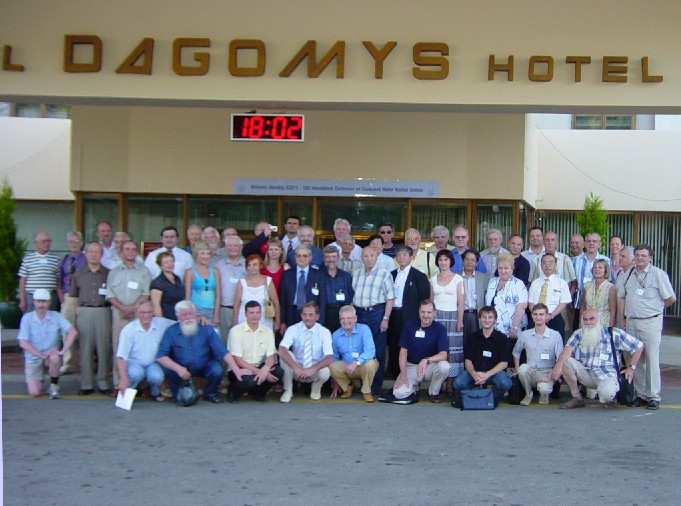
Photo: S. Krivit
This report reviews a few of the highlights from the 13th International Conference on Condensed Matter Nuclear Science, held in June at Dagomys, Sochi, Russia. It is by no means a complete and full report of the excellent work performed by this research community.
Many of the Russian scientists share a strong cross-disciplinary interest in the subject of ball lightning, as well as low energy nuclear reactions. As a result, both subjects were included in the formal program. However, ball lightning does not fall within the subject matter covered by New Energy Times.
Yuri Bazhutov (Russian Academy of Sciences), Igor Goryachev (Kurchatov Institute), Nicolai Samsonenko (People's Friendship University), Irina Savvatimova (Federal State Unitary Enterprise) and others put an amazing amount of energy into the conference and pulled off a very effective meeting.
Bazhutov opened the conference with a formal welcome (audio), and Goryachev provided an inspiring vision (audio) for the conference.
"Our Russian television has been stating that the city of Sochi is a possible site for the 2014 Winter Olympics," he said, "and that Sochi is the gateway to the future. I am sure that our ICCF-13 conference here at Dagomys, Sochi will be the gateway to the future."
The audience was honored to receive welcome addresses by several individuals, including Vladimir Bychkov, on behalf of Vitaliy Mikhailin, the president of the Russian Physical Society, as well as a private individual, Andrey Mozzhegorov, who helped sponsor the conference.
Mozzhegorov was initially inspired to contribute to the conference as a result of a question one of his daughters asked him. She knew that he was an advocate for science and technology, but she was aware that such progress has contributed to many ecologically unfavorable situations around the world. She asked him what he could do to apply science and technology to help make the world better.
Sometime after that, Mozzhegorov heard about the CMNS research community and began to look into the area. Mozzhegorov is not a scientist; he is an attorney and formerly a fighter pilot for the Russian military.
He was impressed with the CMNS researchers; he noted that they often explored beyond the limits of the ordinary and practiced out-of-the-box thinking. He found this inspiring. Likewise, the CMNS found his and his wife Olga's participation inspirational.
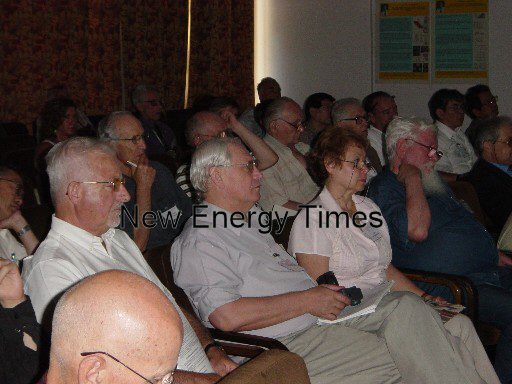
ICCF-13 Audience: Left to right: Pierre Clauzon, Yuri Bazhutov, Irina Savvatimova, Fangil Gareev
Photo: S. Krivit
This link will provide access to the program, abstracts and other conference information. Very few papers were distributed at the meeting. New Energy Times has obtained a few of them and will provide links within this report.
The proceedings may take a year or two to publish; therefore, readers who would like further details are encouraged to check online at Edmund Storms and Jed Rothwell's www.LENR.org library for uploaded papers/presentations, or contact the authors directly.
At times, barriers existed to obtaining papers or more complete details on the presentations. Sometimes, these barriers were the result of language difficulties; sometimes, these apparently were the result of proprietary commercial interests that led the researchers to keep important details under wraps.
A significant, paradoxical trend continues; as more commercial funding is coming into the field, researchers are engaging in less open exchange, outside of those researchers who share information within their collective business partnerships.
Many of the researchers use the term "cold fusion" in their presentations despite the fact that the underlying mechanism(s) is (are) still in dispute. The wisdom of such decisions, or old habits, seems uncertain because the speculative historical term has a tendency to confuse observers of the field who otherwise might regard the rigorous experimental findings with greater respect.
Despite the fact that no breakthrough announcements were delivered at the Sochi conference, the fact that excess heat and anomalous nuclear products continue to be reported, year after year, are a testament to the truth and likely significance of these novel effects of nature.
Preparata Medal Award Winners
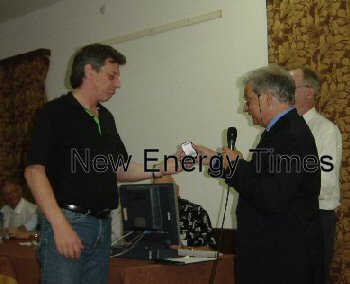 |
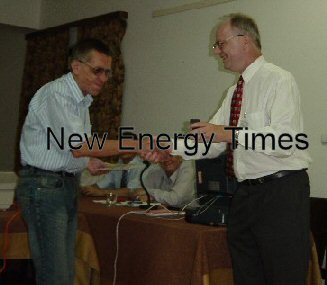 |
Andrei Lipson receives Preparata Award from
Franceso Celani Photo: S. Krivit |
Alexander Karabut receives Preparata Award from
William Collis Photo: S. Krivit |
The condensed matter nuclear science community has awarded prizes to its members for outstanding achievements dating to 1993, when the "Truffle Prizes" were first awarded by the Italian automotive group Fiat.
Those prizes eventually were replaced by the Preparata Medal, in honor of Italian physicist Giuliano Preparata. The production of the current set of medals was sponsored by the Fondazione Cassa di Risparmio di Asti, part of a local banking institution whose mission is to further scientific search, education, the arts, and culture.
This year's prizes were awarded to Russian scientists Andrei Lipson of the Russian Academy of Sciences and Alexander Karabut with Federal State Unitary Enterprise "Luch."
John Dash, Wu Shou Zhang and Hideo Kozima Report Excess Heat
John Dash, professor emeritus of physics, with the Low Energy Nuclear Laboratory at Portland State University, and Wu Shou Zhang, with the Institute of Chemistry at the Chinese Academy of Sciences, described by Dash as a calorimetrist, theoretical physicist, and excellent experimentalist, reported a confirmation of a LENR phenomena that has been observed for many years; as the temperature of the electrolyte is permitted to go (or brought) to higher temperatures, the excess heat effect is amplified.
This effect also is referred to as positive feedback: the more heat that exists within the cell, the more likely excess heat is to occur.
Zhang and Dash report that "best results are obtained when the electrolyte temperature is close to the boiling point."
Italian researcher Giuliano Mengoli explicitly noted this effect in his paper "Calorimetry Close to the Boiling Temperature of the D2O/Pd Electrolytic System."
Zhang and Dash used isoperibolic calorimetry and Seebeck envelope calorimetry concurrently, and the results of each method agreed with the other.
They reported that they "were able to obtain excess heat output from 12 consecutive samples" in the multimilliwatt range with a confidence level of five sigma. They also reported the anomalous "presence of silver on the palladium surface after electrolysis in heavy water."
During the mid-1990s, mass flow calorimetry was a favored choice of LENR researchers as a reaction to critics' reluctance to accept results from isoperibolic calorimetry, which is highly complex and relatively inaccessible to nonspecialists.
Mass flow is far simpler, and critics claimed they would not accept excess heat claims from mass flow calorimetry. After such results were obtained, critics subsequently came up with additional objections to avoid the uncomfortable hypothesis of excess heat.
But mass flow calorimetry had and has a significant disadvantage. The circulating flow has a tendency to keep the experiment cool and unfortunately inhibit optimal results.
As a consequence of this limitation, resuming the use of isoperibolic calorimetry may now be more useful for researchers. When combined with a secondary envelope-type calorimetry system, the results become notably rigorous.
Dash et al. state in one of their papers, "Since the discovery of excess heat in 1989, the reproducibility has been a difficult problem. Our results suggest a reason why Fleischmann and Pons and other groups observed excess heat using Dewar-type electrolytic cells and isoperibolic calorimetry, but some groups using mass-flow calorimetry had difficulty detecting excess heat, or the reproducibility was very poor.
"The reason is that the latter method involves a low temperature, semi-isothermal measurement. The temperature difference between the electrolytic cell and the water flowing during electrolysis is very small. Therefore, this system has to be stimulated by various methods, e.g., high input power, laser irradiation etc. Even then, the reproducibility is still low because the cell temperature is not high enough.”
Dash et al. reported periodic excess heat bursts in the 0.5 Watt range and bursts of up to 2 watts, as Dash reported to New Energy Times during a follow-up interview.
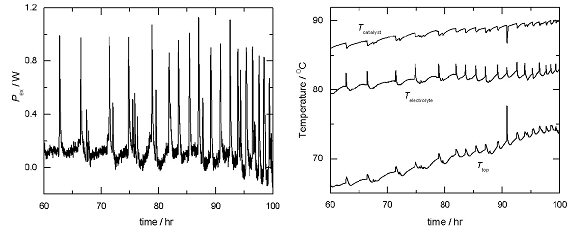
Heat bursts and corresponding temperatures during electrolysis
New Energy Times spoke with Dash about another anomalous observation from his team. Dash uses thin cold-rolled palladium foils for his cathodes, and these cause interesting effects. Soon after the electrolysis begins, within minutes, the cathode develops an unusual bend visible to the naked eye.
"That by itself turned me on to this in 1989," Dash said. "How can this happen? It's opposite of what you'd expect because the side facing the anode has a higher current density and if you form the hydride, it involves an expansion. But this result says that it involves a contraction on that side. So there's a big mystery."
Dash interpreted the bursts as mini-explosions, similar to that reported by researchers in China (Zhang and co-workers), Japan (Mizuno), and France (Biberian).
"It busted their cells," Dash said. "I think in all the cases, they were open cells so there would not have been a pressure buildup. In our experiments, it appears we are getting explosions, but they are controllable explosions. When you drive your car, that's what you're getting, controllable explosions, and that's what we need here."
Dash also explained that they place their Seebeck envelope calorimeter within another box to isolate it thermally from the room environment. They found this was necessary to obtain optimal results. However, he states, researchers who have controlled room temperature environments wouldn't need the secondary enclosure.
They also reported experiments using mass and gamma ray spectroscopy indicating anomalous isotopic abundances and unexpected elements.
"The changes in isotopic abundance and the occurrence of unexpected elements can be explained," Dash wrote, "if thermal neutrons are produced during electrolysis and during glow discharge."
Excess Heat Reported by Clauzon
Pierre Clauzon, a former nuclear engineer who designed the cores for fast breeder reactors, reported 30 percent excess heat in a series of plasma electrolysis experiments that he claims was 100 percent repeatable in his lab. Measurements were made using a steam calorimeter at the Laboratoire de Sciences Nucléaires in Paris.
Clauzon exemplified the persistence of many of the CMNS researchers, saying of himself, a Frenchman, "the frog will never give up."
Excess Heat Reported by Celani
Francesco Celani, a physicist with the Italian National Institute of Nuclear Physics, reported results of an Arata-style double-wall structure experiment using palladium nano-powders, though the specific details of his claims were difficult to follow.
Karabut Reports Excess Heat Interpretation
Alexander Karabut, with Federal State Unitary Enterprise "Luch," presented data showing an experiment which yielded 300 watts output as a result of an unusually high energy source. New Energy Times was unable to obtain copies of his presentation; however, we spoke with him afterward to learn more details.
We learned that Karabut's presentation was his own theoretical treatment of data from an experiment performed around 1994 by another group of Russian researchers.
Karabut explained to New Energy Times that the spectacular results that he reported at ICCF-13 were not based on his own data but were those of the other group. He says that their results confirm his ideas. Unfortunately, Karabut said, all but one of the six or seven members of that group are dead.
Karabut hopes to repeat their experiment himself in the near future.
Toyota Replication of Mitsubishi Transmutation
After many years of absence from the field, Toyota has re-emerged on the CMNS scene through the work of Tatsumi Hioki, Naoko Takahashi and Tomoyoshi Motohiro at Toyota Central Research and Development Laboratories Inc. in Nagakute, Aichi, Japan.
The researchers have attempted to replicate the Yasuhiro Iwamura deuterium gas permeation experiment performed at Mitsubishi Heavy Industries. The Toyota team reported an experiment that showed mildly positive evidence of the low energy nuclear transmutation of cesium into praseodymium.
Nagel Reports on LENR Reaction Rates
David Nagel, a research professor at George Washington University, presented a paper on reaction rates for low energy nuclear reactions at surfaces. In this paper, he reviewed the effects on surface phenomena as observed with regard to the Letts-Cravens laser effect, the Arata/Zhang palladium-black material, and the Iwamura transmutation experiments. He also made note of an experiment performed by Edmund Storms in which he reversed the polarity of the electrodes and observed anomalous behavior including excess heat.
Nagel referred to the fourth paper (in pre-print) by Allan Widom and Lewis Larsen that gives estimates and an expression for reaction rates of10E12 to 10E14 reactions/second/cm2.
Nagel's review also displayed a perspective of the various material geometries and the range of their effects when going from millimeter to micrometer to nanometer scales.
He made his best attempt to quantify the characteristics of power generation but admitted that a complete, comprehensive analysis was out of reach because of too many unknown parameters.
He pleaded to the experimentalists, "Measure or estimate your total surface area," and to the theoreticians, "Provide values for the reaction rates per area."
China Institute of Atomic Energy Contributes Paper
Songsheng Jiang of the China Institute of Atomic Energy contributed a paper, along the lines of work by Steven E. Jones (formerly of Brigham Young University), reporting evidence for naturally occurring fusion in the earth.
Lipson on H/D Loading
Andrei Lipson (Russian Academy of Sciences) et al. presented new research on the use of single-wall carbon nanotubes to enhance the diffusion of deuterium/hydrogen into palladium. He also reported a rigorous method of particle detection using CR-39 detectors which indicated 3.0 MeV (DD) protons and high energy alphas in a repeatable experiment.
Lipson et al. also took a comprehensive look at nuclear signatures in CMNS experiments and reported findings and particle energies from glow discharge experiments recorded with the use of CR-39 detectors and metal filters.
Exploding Wire Experiments
Two Russian groups, one from the Ryazan State Radio Engineering University and another from the Russian Federal Nuclear Center, reported results from exploding wire experiments; however, the significance and conclusions are difficult to understand. A.N. Vlasov, from Ryazan, reported that the wire was vaporized in the course of the explosion.
Bazhutov Reports Neutrons, Tritium
Yuri Bazhutov presented several papers, but one particular experiment that he reported stood out. He reported that "large neutron yield reached a value of 10E6 neutrons per second with correlated tritium yield value ~ 10E11 in heavy water & much less in light water" in his paper "Neutrons, Gamma-Rays & Tritium Diagnostic at Electrolysis with Anode Gas Discharge in Water Solution."
Alexander Koldamasov's Hydraulic-Electrostatic Device
Two years ago, New Energy Times first reported the work of Alexander Koldamasov, brought to Edmonton, Canada, by Hyunik Yang. Yang partnered with Patrick Cochrane and his Innovative Energy Solutions Inc. business partners in an attempt to develop the Koldamasov method into a commercial product. They didn't do so well. They took a few million dollars from small private investors, produced nothing and ended up in bankruptcy.
A default judgment was issued on Aug. 29 in Clark County, Nev., district court against Ronald Foster, Patrick Cochrane and Frederick Dornan with compensatory damages of $15 million and punitive damages of $45 million.
Real science and potentially viable technology may be behind Innovative Energy Solutions Inc.'s failed attempt, but the lesson to learn here, as always, is caveat emptor, and watch out for the snake oil.
Yang has continued with his attempts to develop the method into a commercial product with a few deep-pocket private investors, and he has kept very quiet since his unfortunate experience in Edmonton. Yang has not appeared at any CMNS conference since the 2005 conference in Yokohama, Japan.
New Energy Times was able to speak with Koldamasov during the Sochi meeting and learn a great deal about the background of this work. This will be featured in a future article.
__________________________________________________________________________________
5. Excess Heat Report from Jean-Paul Biberian and Nicolas Armanet
By Steven Krivit
Photos: Nicolas Armanet
At the 13th International Conference on Condensed Matter Nuclear Science, which took place in June at Sochi, Russia, the French duo of Jean-Paul Biberian and Nicolas Armanet at the Université de la Méditerranée in Marseilles reported an excess heat experiment that produced 5 watts of excess heat. The experiment used a 50-Watt input to the cell, and they reported that it produced 10 percent excess heat. However, in follow-up interviews, Biberian restated that the excess heat was closer to 2.5 watts, which is still quite significant.
They stated that the precision of their calorimeter was +/- half a watt and that the excess heat ran for three days continuously. The excess began to register after the experiment had been running for 18 days. The excess heat stopped only when they decided to terminate the experiment so they could attempt to repeat it.
"Initially we felt a lot of excitement as well as scepticism," Armanet said, "because there had been many times when we thought we had excess heat and later on we discovered an artifact."
Their excess-heat experiment is the result of an apparatus they constructed which is modeled after the designs of Yoshiaki Arata of Osaka University, Japan, which Arata reported at ICCF12 in Yokohama, Japan, in 2005.
Arata is a highly respected physicist in Japan and is recognized as the first to have brought hot fusion research to the country.
"The gas phase experiment of Arata is very similar to work Arata did earlier with the double-structure cathode," Biberian said. "The only difference is the absence of electrolyte and the fact that the deuterium is injected from a gas instead of dissociation of heavy water.
“I was also encouraged by Xing Zhong Li's (Tsinghua University, Beijing) work where he found excess heat by diffusion of deuterium through palladium."
Armanet also gave credit to a 1989 experiment performed by Gustave C. Fralick et al. at NASA's Lewis Research Center which produced excess heat when they loaded and deloaded deuterium from a palladium hydrogen purifier.
Biberian told New Energy Times that he was able to design the experiment following the information given in Arata's presentation and U.S. patent, independent of any personal communication with Arata.
Arata's reactor represents a more recent evolution in his double-structure designs from his early paper published in the proceedings of the Japanese Academy of Sciences.
Biberian writes that the Arata design measures temperature and suggests the presence of excess heat. However, that design does not incorporate calorimetry, and this is the improvement that the Biberian and Armanet design contributes.
In 2000, a team at SRI International, led by Director of Energy Research Michael McKubre, was the first to report a replication of an Arata double-structure design. The team registered excess heat, tritium and helium-3 evolution.
Biberian and Armanet tried a total of 23 variations using this experimental design, and it was number 11 that yielded the excess heat. They varied different parameters after number 11, none yielded excess heat.
"The major difference between the successful run and the others," Armanet wrote, "is the fact that in the working tube we had oxidized the palladium prior to starting the experiment. In the prior and later experiments we did not do that. We are in the process of repeating a similar experiment.
"In run 11, after 18 days, we closed the valve of the reaction chamber and let the pressure of deuterium rise as it was flowing through the palladium tube. This is when we observed the excess heat. Many factors are involved that we do not yet know; the role of temperature, oxidation of the palladium, deuterium pressure in the reaction chamber etc."
Biberian was unable to attend the Russian conference. However, his colleague Armanet, 27, probably the youngest presenter in the room, let alone the entire CMNS field, did a magnificent job in Biberian's place.
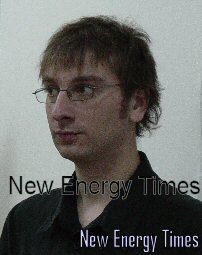
Nicolas Armanet Photo: S. Krivit
|
Armanet is one of a few researchers of a younger generation to participate in and to bring forward stunning results in the field. The transmutation work of Yasuhiro Iwamura, with Mitsubishi Heavy Industries in Japan is now legend, attested to by the many replications performed after his experiment design.
"Our motivation to replicate Arata's experiment," Armanet said, "was based on three characteristics of his experiment: large excess heat, large ratio of power out to power in, and long duration of excess heat."
Armanet earned his degree in chemistry and carries out additional studies in physics at Université de la Méditerranée in Marseilles.
He worked as a chemist in commercial laboratories from 1999 through 2006, then quit his job to work on LENR experiments. He stumbled on the field when he read the 2004 LENR article in Science & Vie written by Cecilie Bonneau.
|
Armanet works with Biberian without pay because of his passion and interest in the subject.
"The possibility to make nuclear reactions in such unusual low energy environments captured my attention." Armanet wrote. "And so to participate in a new field of science is an opportunity that I did not want to miss. I didn't hesitate.
"I attended the 6th Workshop on Anomalies in Hydrogen and Deuterium loaded Metals in Siena in May 2005 in order to meet scientists in the field. A year later, in Sept. 2006, Biberian offered me the chance to work with him, and since then I have been working full time on LENR research."
Funding is scarce in this field, not because of a lack of scientific evidence but because of the lingering disdain which many journal editors and science advisers still feel.
It was difficult to begin learning about the subject, Armanet told New Energy Times.
"Nothing exists in French," Armanet said, "except Bonneau's article. But then I discovered the online library maintained by Jed Rothwell and the International Society for Condensed Matter Nuclear Science (ISCMNS) organized by William Collis and I started to learn things. The Student's Guide written by Edmund Storms was particularly helpful. Many other people in the CMNS community have also provided a very welcome atmosphere for me."
"Biberian started the experiments in March 2006 and I joined him In Sept. 2006," Armanet said. "It's a very new experiment, and each test takes a long time, as does the evaluation period. There are a variety of factors we can explore: pressures, temperatures, etc., and in this context each run can last several days or even months."
They had no guide as to how long to let each variation of their configuration run. Historically, some LENR experiments take weeks to begin to register excess heat, but others start within minutes. They terminated many of the experiments for a variety of reasons. Sometimes, they ran out of patience waiting for a result and decided to re-engineer the experiment for an improved result; other times, they observed a problem with either a leak in the palladium tube or with the instrumentation.
Biberian and Armanet worked with deuterium gas (D2) rather than deuterium in a heavy water electrolysis experiment because D2 gas is easier to experiment with than electrolysis, Armanet said.
"Other advantages," he said, "is that there is theoretically no limitation of temperature. With electrolysis, you are limited to 100 degrees C and then your solution boils away. In our D2 gas configuration, we can go up to 550C, and we have performed experiments anywhere from 30 C to 300 C."
Armanet explained the configuration: The simple explanation is that the process diffuses D2 gas through the walls of a palladium tube. The tube is 10cm long, 2.0mm diameter, and 0.2mm thick. Palladium power is the other key component, and this is placed within the palladium tube. The entire configuration is put under pressure as a result of the incoming D2 gas.
The complete design comprises three nested chambers: the Pd tube, the reaction chamber and the outer, calorimeter chamber.
The diagram below shows the overall schematic:
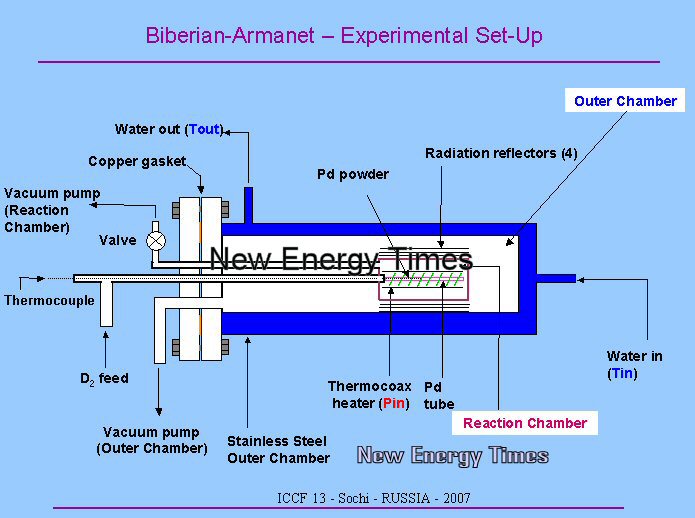
A mass flow calorimeter system measures the heat. Distilled water enters the outer chamber at the "water in" mark on the right, regulated at 30 C, and a sensor measures the inlet temperature (Tin.) The outer chamber is a double-walled stainless-steel cylinder through which the water flows. At the other end, toward the side, water flows out, and its temperature is measured at Tout. At the other end of the outer chamber are connectors for the D2 gas pumping.
There is also a secondary, independent temperature measurement system, a thermocouple that goes inside the center of the palladium tube.
The reaction chamber is designed as follows:
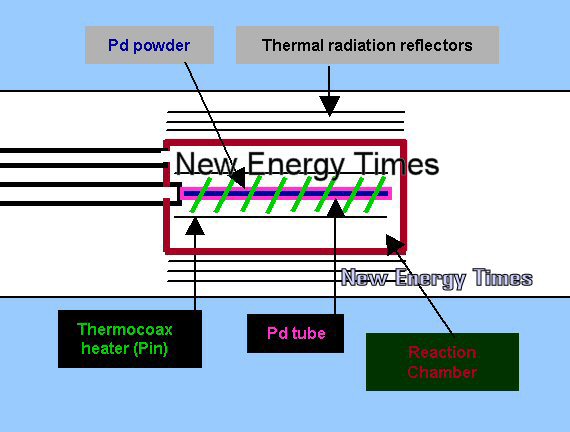
Inside the heart of the reaction chamber is a Pd tube - 10cm long, 2.0mm in diameter, and with a 0.2mm wall thickness. This tube is closed at one end and receives D2 gas from the other end. The volume of the tube is 90 percent filled with Pd power, which amounts to less than one gram of Pd.

Their next step is to set up the conditions to deposit a layer of titanium (in the past, they have also used gold and zirconium) on the outside of the Pd tube. They do this by wrapping a titanium foil around the tube. When the experiment starts, the titanium is deposited in situ on the outer surface of the palladium tube with the aid of a heating resistor.
The purpose of the titanium deposit on the outside of the Pd tube, the researchers speculate, is to provide a screen for the Coulomb barrier.
The heating resistor is a thermocoax coil heater which wraps around the Pd tube and is covered with a shield to reflect the heat. The build sequence of the reactor core is as follows:
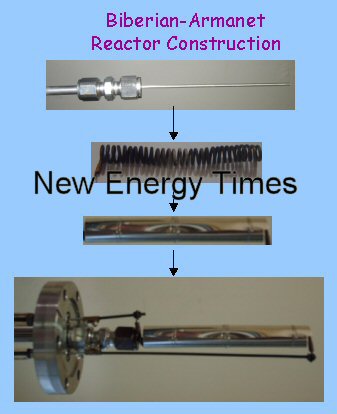
From there, the reactor core is inserted into the reactor core housing.

The core housing is wrapped with an insulating blanket to reflect thermal radiation back into the core. The assembled core housing looks like this:
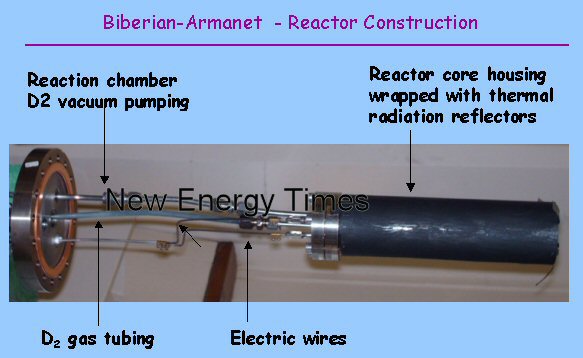
The core housing is inserted into the calorimetry chamber.

When fully assembled, the benchtop apparatus, wrapped with more insulation, looks like this:
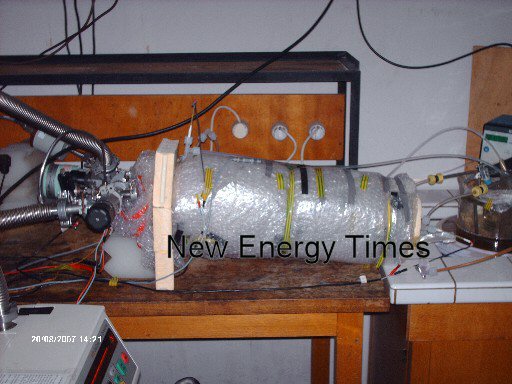
The researchers can perform the experiment at either room temperature or higher temperatures, thanks to the thermocoax heater wrapped around the Pd tube. The heater is the only source of power going into the cell. This heater and the gas pressure are the only energy inputs to the cell. The excess heat experiment occurred with a temperature of 80 C inside the palladium tube.
D2 gas is fed into the Pd tube at 9atm. They have used input pressures ranging from 3 to 15atm. D2 gas diffuses out of the Pd tube and into the reaction chamber. From there, it is either pumped out or it accumulates inside the reaction chamber if the valve is closed.
The vacuum is 10E-3 torr within the reaction chamber and 10E-6 torr within the outer chamber.
The have performed many configuration variations and a variety of material configurations within and on the outside of the Pd tube, including Patterson-type multilayer beads, powders and catalysts, titanium-deposits and sub-micronic Pd power (80-180 nanometer). They did not obtain any excess heat with any of these configurations.
They finally achieved an excess heat result after they oxidized the Pd tube in a 500 C furnace, in air, for two hours, then inserted the Pd powder into the tube.
Their goal now is to test the configuration with nano-Pd powder, to take advantage of the well-known fact that increased surface area promotes excess heat reactions. They hope to use Pd particles under 50 nanometers in size.
Armanet said that the data they presented was very preliminary and that they have much more work to do.
This experiment is an excellent example of the challenge of this work. Without a clear theory to guide the work, an infinite number of variables are present; the parameter space is extremely broad.
At the conference, Armanet was not particularly enthusiastic about his and Biberian's experiment that, they thought at the time, produced 5 watts of excess heat. He did not consider the result very impressive.
He was overwhelmingly contradicted by many people in the audience at the conference.
"I wouldn't call 5 watts small," Michael McKubre, director of energy research at SRI International said. "I would call that heroic, actually. The experiments we did with the Les Case replication yielded, at most, 170 mw from 10 grams of material. Yours is at least two orders of magnitude larger than our replication."
Michael Melich, faculty member of Naval Post-Graduate School in Monterey, Calif., asked whether the experimenters had observed water in the palladium power after the heat-generating run. Armanet said they did not.
"This is not a weak result," Melich said, "you have significant excess heat; 10 percent may be small but the amount is not small, and the signal to noise is very good."
New Energy Times discussed the reported data with Biberian after the conference, and he notified New Energy Times that they had found a calculation error that puts the excess heat at 2.5 watts rather than 5. Still, 2.5 is quite remarkable, considering that many LENR experiments produce only milliwatts of excess heat.
Armanet was very reserved and modest at the conference.
"We must reproduce it before getting too excited about it," he said.
__________________________________________________________________________________
6. Global Energy Outlook and the Realities of Greentech
By Steven B. Krivit
Part One: Global Energy Outlook
I spend most of my working hours carrying out journalistic investigations into energy research.
This report will cover energy issues on a global scale - something which seems sorely lacking in the many conversations about energy and environment we hear.
Solar, wind, and ethanol have been receiving a lot of attention recently. But what is the realistic potential of these "Greentech" or "Cleantech" (depending on whom you talk with) alternatives?
Certainly, fringe energy research has no solutions right now, but for point of disclosure, these are my favorite energy topics to watch. I like the fringe for the same reason that venture capitalists like high-risk ventures: potential for high reward - in this case, potential for breakthrough answers to the energy challenge.
Maybe I'm silly for my willingness to look like a fool by covering these areas. Maybe not. We'll see. I have been called bad names, people close to me have been the targets of insults and I have had a few lightly veiled threats to my physical well-being. But these sorts of things tend to propel me on rather than deter me from sorting out the facts from the fiction in the wild world of leading-edge energy research.
Fictions in the energy field abound; the facts, many of them obfuscated by complex layers of marketing-speak, are not often accessible to the layperson.
Fringe energy research is even more challenging: A vast ocean of the unknown abounds. Most of the claims probably will turn out to be garbage, a few outright snake oil, but a small percentage may end up being golden.
Conventional renewables, such as solar or wind power, are not mysterious. These technologies have been around for a long time, the underlying science is well-understood, and there are few disputes, political, scientific or environmental.
However, solar and wind are not global solutions for base load electricity or transportation fuels. On a national scale, they are a drop in the bucket compared to coal, natural gas and nuclear for electrical production.
Any suggestion that solar or wind can now or will soon save the planet or save us from resource wars is unsupported.
Technological breakthroughs in any area of research are always possible and likely, and solar and wind energy research are certainly worthy endeavors.
With significant increases in research funding or commercial market share, which would provide better economies of scale, major breakthroughs are possible and likely.
To claim that solar and wind are the answer, to the exclusion - or worse, to the derision - of other solutions is either ignorant or indicative of self-interest.
I was surprised and dismayed to hear Larry Page, co-founder of Google Inc., propose such an agenda, praising the virtues of wind and solar and bashing nuclear during his keynote speech at the annual meeting of the American Association for the Advancement of Science on Feb. 16, 2007.
As I sat there in the San Francisco Hilton listening to Page, I wondered how his Google teammate, Jack Ancone, principal of New Business Development, who sat at a table near me at the National Energy Symposium organized by John E. Cox Jr. of The Communications Institute in Los Angeles last year, missed the message about the limitations of solar and wind. (Audio and video recordings of the symposium are available through the National Energy Symposium Web site.)
Henry Lee, director of the Environment and Natural Resources Program at Harvard University voiced the consensus of these energy experts.
"There is no silver bullet," Lee said.
I'll get back to this in Part 2 of this report.
Midway through the day's presentations in Los Angeles, I walked up to Ancone and introduced myself. He was surprised and asked whether I had known that Google was interested in energy and the environment. I said no, but I assumed that they should be, considering how integral energy is to their business.
But I've been mulling this over. Maybe Ancone heard a different message.
Perhaps, after listening to national experts on solar, wind, biofuels and fusion paint their universally grim outlook on foreseeable energy solutions, he decided that solar and wind likely would be a lucrative business opportunity.
I suppose I had assumed that Google, the great equalizer of free and accessible information, also might be a great provider of free, accessible energy information that was neutral and unbiased. I may have been mistaken.
Part Two: Wind And Solar Realities
So why is wind not a silver bullet?
On a global or even national scale, there is not enough where we need it, when we need it, and its energy does not come in the form we need it most.
So why is solar not a silver bullet?
Nathan Lewis, a Caltech chemist who is a proponent of solar energy, hits the nail on the head, as quoted in The New York Times on July 16.
“The scale on which things actually have to happen on energy is either not fully appreciated or transmitted to the public,” Lewis said. “You have to find a really cheap way to capture that light, for the price of carpet or paint, and also convert it efficiently into something humans can use for energy.”
One venture capitalist in the heart of Silicon Valley's venture capital neighborhood has had the courage to say what the other venture capitalists on Sand Hill Road don't want you to hear. According to Vinod Khosla, quoted in
a July 16 article by Andrew C. Revkin and Matthew Wald in The New York Times, solar technology is, at the moment, nothing more than a boutique investment.
“Most of the environmental stuff out there now is toys compared to the scale we need to really solve the planet’s problems,” Khosla said.
Part of the problem that Khosla and others have found in investing in solar research, however, is that the volatility - circumstantial or intentional - of crude-oil prices has turned solar research and investment into a roller-coaster ride.
According to the Energy Information Administration (http://www.eia.doe.gov/), solar energy provided a mere one-tenth of 1 percent of the total U.S. electrical supply nationwide.
No wonder. How many people who pay $100 a month for their electric bill will pay $700 voluntarily? This is derived from the production costs of electricity, based on 2002 statistics, that Lewis showed in his 2006 presentation at the Los Angeles Energy Symposium.
According to the Times article, "'even a quarter-century from now,' says the Energy Department official in charge of renewable energy, 'solar power might account for, at best, 2 or 3 percent of the grid electricity in the United States.'"
The Times article says that, "in the meantime, coal-burning power plants, the main source of smokestack emissions linked to global warming, are being built around the world at a rate of more than one a week."
Some people dismiss the whole idea of global warming, but few people dispute that supply of oil and gas soon will be overtaken by demand. The world needs to find a new source of energy within a few decades or face an unprecedented downturn in the quality of life, as we become slaves to our energy addictions and warriors for these resources.
Richard E. Smalley, who was a professor at Rice University and earned worldwide recognition for his work in nanotechnology, laid it out simply in a 2003 presentation given at the Houston Museum of Natural Science.
World population is expected to reach 10 billion people by the year 2050, many areas of the world are becoming more industrialized and the per capita demand for energy is increasing. Cheap oil and gas will be history by the year 2030, if not sooner.
"At a minimum," Smalley wrote, "we need 10 teraWatts from some new clean energy source by 2050" and "for worldwide peace and prosperity, we need it to be cheap. … The remaining oil reserves are not where we want them. … For transportation fuels, we currently have no choice."
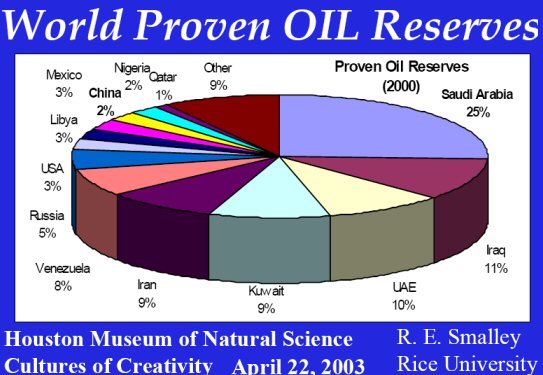
World Proven Oil Reserves
The pie chart above is missing Canada, with its vast oil resources in the tar sands of Alberta; however, the extraction costs are still higher than conventional crude.
Part Three: So What Can We Do?
The first thing is to get real about the fact that no one technology - solar, wind, conventional nuclear, or, heaven forbid, cold fusion - is going to save the planet. There are no easy answers.
The technology for solar isn't there. Wind isn't in the right places, at the right time, in the right quantities. The engineering for hot fusion is 30 to 90 years away (depending on whom you ask). The underlying science for low energy nuclear reactions, "cold fusion," isn't there. The trust factor for nuclear fission isn't there. The idea of "clean coal" is in dispute, and coal liquefaction is not economical.
For perspective, if a nuclear fission approach is used to provide for the expected shortfall of 10 teraWatts of capacity that is foreseen by experts, using 1 gigaWatt reactors would require the construction of 10,000 new reactors, one every other day for the next 50 years.
Some groups, like the Post Carbon Institute, suggest that we should pre-emptively reorganize the way we live, work and play based on the impending energy challenges. I suspect that only a fraction of the world's population will have the luxury to consider such a philosophy, let alone the discipline to power down voluntarily.
Wind, solar or other conventional renewables might be able to carry the day in 25 or 50 years. But can anyone know that, for certain? And is it worth risking the future of humankind to put all bets on one horse?
Some prominent members of the public are beginning to ask new questions about nuclear fission. These include environmental and opinion leaders such as Stuart Brand, founder of The Whole Earth Catalog, and Patrick Moore, a founder of Greenpeace.
I recently spent several days listening to some of the world's experts on nuclear power at the International Conference on Emerging Nuclear Energy Sciences. I heard many strong and potentially useful ideas proposed.
Some of these include an entire new class of nuclear reactor designs called Generation IV reactors, which include passive failsafe systems that would shut down a reactor automatically if something goes awry.
As Lewis points out, in the long run, a three-pronged approach will be the safest and likely most successful strategy for the planet's sources of carbon-free power.
1. Nuclear
2. Carbon sequestration (particularly of coal)
3. Development of conventional renewables, particularly solar
The second thing is to realize that we need leadership and wisdom at high levels in every nation, as M.I. Hoffert wrote in Nature in 1998.
"Without policy incentives to overcome socioeconomic inertia," Hoffert wrote, "development of needed technologies will likely not occur soon enough to allow capitalization on a 10-30 teraWatt scale by 2050.”
The good intentions of people who can afford to purchase solar panels and plug-in hybrids will have little consequence when the people of China are building one new coal plant per week.
Hoffert, and others like him have been saying the same thing for many years.
“Researching, developing, and commercializing carbon-free primary power technologies capable of 10-30 teraWatt by the mid-21st century could require efforts, perhaps international, pursued with the urgency of the Manhattan Project or the Apollo Space Program,” Hoffert wrote.
Who is listening?
__________________________________________________________________________________
7. SCIENCE AND ENERGY NEWS
Click on any headline to read the entire article.
As Congress Turns to Energy, Lobbyists Are Out in Force
By Edmund L. Andrews
The New York Times
Tuesday, June 12, 2007
Having tried and failed to overhaul the nation's immigration laws last week, Congress begins what some say is an even more divisive project this week: taming America's thirst for oil.
With gasoline prices hovering near all-time highs, the Senate on Monday began debating a sprawling energy bill that has already kicked off an epic lobbying war by huge industries, some of them in conflict with one another: car companies, oil companies, electric utilities, coal producers and corn farmers, to name a few.
(article continues)
Defining An Industry: Cleantech vs. Greentech
Submission by Neal Dikeman
Yahoo Finance
Monday, July 16, 2007
Regarding the Cleantech vs. Greentech debate . . . I chaired the recent Greenvest 2007 conference in San Francisco a couple of weeks ago on investing in green technology. Nick Parker, Chairman of the Cleantech Group, did an opening address on the state of the industry - which brought to mind the question of what exactly one should call the industry.
(article continues)
The Energy Challenge: Solar Power Wins Enthusiasts but Not Money
By Andrew C. Revkin and Matthew L. Wald
The New York Times
Monday, July 16, 2007
The trade association for the nuclear power industry recently asked 1,000 Americans what energy source they thought would be used most for generating electricity in 15 years. The top choice? Not nuclear plants, or coal or natural gas. The winner was the sun, cited by 27 percent of those polled.
It is no wonder solar power has captured the public imagination. Panels that convert sunlight to electricity are winning supporters around the world — from Europe, where gleaming arrays cloak skyscrapers and farmers’ fields, to Wall Street, where stock offerings for panel makers have had a great ride, to California, where Gov. Arnold Schwarzenegger’s “Million Solar Roofs” initiative is promoted as building a homegrown industry and fighting global warming.
But for all the enthusiasm about harvesting sunlight, some of the most ardent experts and investors say that moving this energy source from niche to mainstream — last year it provided less than 0.01 percent of the country’s electricity supply — is unlikely without significant technological breakthroughs. And given the current scale of research in private and government laboratories, that is not expected to happen anytime soon.
(article continues)
Iron to Plankton To Carbon Credits: Firm's Emission Plans Have Critics Aplenty
By Steven Mufson
The Washington Post
Friday, July 20, 2007
A small California company is planning to mix up to 80 tons of iron particles into the Pacific Ocean 350 miles west of the Galapagos islands to see whether it can make a splash in the markets where people seek to offset their greenhouse gas emissions.
Planktos -- with 24 employees, a Web site and virtually no revenue -- has raised money to send a 115-foot boat called the Weatherbird II on a voyage to stimulate the growth of plankton that could boost the ocean's ability to absorb carbon dioxide from the air. The company plans to estimate the amount of carbon dioxide captured and sell it on the nascent carbon-trading markets.
(article continues)
Energy Bill Aids Expansion of Atomic Power
By Edmund L. Matthews and Matthew L. Wald
The New York Times
Tuesday, July 31, 2007
WASHINGTON, July 30 — A one-sentence provision buried in the Senate’s recently passed energy bill, inserted without debate at the urging of the nuclear power industry, could make builders of new nuclear plants eligible for tens of billions of dollars in government loan guarantees.
Lobbyists have told lawmakers and administration officials in recent weeks that the nuclear industry needs as much as $50 billion in loan guarantees over the next two years to finance a major expansion.
(article continues)
The Big Melt
By Nicholas D. Kristof
The New York Times
Thursday, August 16, 2007
The latest source of alarm is the news, as reported by my Times colleague Andrew Revkin, that sea ice in the northern polar region just set a new low and it still has another month of melting ahead of it. At this rate, the permanent north polar ice cap may disappear entirely in our lifetimes.
In case you missed the May edition of Geophysical Research Letters, an article by five scientists has the backdrop. They analyze the extent of Arctic sea ice each summer since 1953. The computer models anticipated a loss of ice of 2.5 percent per decade, but the actual loss was 7.8 percent per decade three times greater.
The article notes that the extent of summer ice melting is 30 years ahead of where the models predict.
(article continues)
Cold-Fusion Graybeards Keep the Research Coming
By Mark Anderson
Wired
Aug 22 , 2007
CAMBRIDGE, Massachusetts -- At an MIT lecture hall on Saturday, a convocation of 50 researchers and investors gathered to discuss a phenomenon that allegedly does not exist.
Despite a backdrop of meager funding and career-killing derision from mainstream scientists and engineers, cold fusion is anything but a dead field of research. Presenters at the MIT event estimated that 3,000 published studies from scientists around the world have contributed to the growing canon of evidence suggesting that small but promising amounts of energy can be generated using the infamous tabletop apparatus.
(article continues)
Corn-Based Ethanol May Be Obsoleted by Jatropha Plant
(Mali’s Farmers Discover a Weed’s Potential Power)
By Lydia Polgreen
The New York Times
Sept. 9, 2007
...But now that a plant called jatropha is being hailed by scientists and policy makers as a potentially ideal source of biofuel, a plant that can grow in marginal soil or beside food crops, that does not require a lot of fertilizer and yields many times as much biofuel per acre planted as corn and many other potential biofuels. By planting a row of jatropha for every seven rows of regular crops, Mr. Banani could double his income on the field in the first year and lose none of his usual yield from his field.
Poor farmers living on a wide band of land on both sides of the equator are planting it on millions of acres, hoping to turn their rockiest, most unproductive fields into a biofuel boom. They are spurred on by big oil companies like BP and the British biofuel giant D1 Oils, which are investing millions of dollars in jatropha cultivation.
Countries like India, China, the Philippines and Malaysia are starting huge plantations, betting that jatropha will help them to become more energy independent and even export biofuel. It is too soon to say whether jatropha will be viable as a commercial biofuel, scientists say, and farmers in India are already expressing frustration that after being encouraged to plant huge swaths of the bush they have found no buyers for the seeds.
(article continues)
__________________________________________________________________________________
8. The Wizard of Half Moon Bay: A New Energy Times Special Report on Planktos and D2Fusion
by Steven B. Krivit
Part One: Russ George's Solution to Global Warming
"Cold fusion" promoter Russ George is in the news again.
This time, he has the solution to global warming, he says in a 2003 press release, "New Era of Ocean Stewardship Unveiled by Planktos Foundation."
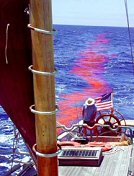
Russ George dumping iron into the ocean from singer Neil Young's schooner "Ragland"
Source (Archive copy)
His publicly-traded company is now called Planktos Corp. It previously was Planktos Inc., before that Diatom Corp.; before that, it was GYK Ventures Inc., and before that eWorld Travel Corp. He intends to drop in the world's oceans iron filings that he believes will fertilize and stimulate plankton growth, which will absorb carbon dioxide, thereby reducing the global warming effect.
George has pursued his interests in fighting global warming under several other company names, as well. These include Planktos Foundation, before that Ocean Carbon Systems Inc., and before that Carbon Corp. However, I was unable to find a record for "Planktos Foundation."
A California corporation search lists the agent for service of process for Planktos Inc. as "Darcy R. George." This explains other documents seen on his Web site listing his name as D.R. George.
George's recent publicity attracted my attention because I had investigated George and a company he registered as D2Fusion Inc.
My first investigation, a package of five articles, appeared in the May 10, 2006, issue of New Energy Times, I published a related editorial in the July 10, 2006, issue, another editorial on March 16, 2007, and another article in the July 10, 2007, issue.
The first thing I found in my investigation of Planktos was that George had recently scored a remarkable photo-op at the Vatican with a representative of the Pope, Cardinal Paul Poupard. Planktos staff members caught the live action on video and have made it available to other media and the public.

Cardinal Paul Poupard accepts a
"carbon-credit"
donation from Planktos
chief executive Russ George. |
The premise that plankton will blossom with the addition of iron has some scientific merit, but the plan that George has constructed around the concept is inadequate, at best.
My first introduction to George's ideas of saving the planet was from the investigation carried out by Wendy Williams of Northern Sky News.
Northern Sky News doesn't seem to be on the Web any longer, but I archived a copy of the "Cashing In on Climate Change" article. “Living on Earth,” a National Public Radio show on affiliate WBUR in Boston, Mass., interviewed Williams and published a copy of her report.
|
Here is an excerpt:
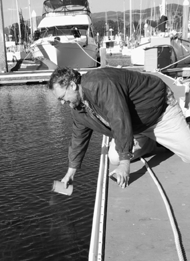
Photo by Greg Auger
Russ George demonstrating the simple but controversial technique of iron fertilization.
|
"A press release on the Planktos site, under the heading “New Era of Ocean Stewardship Unveiled by Planktos Foundation,” touts “the work of the team of dedicated ocean scientists at The Planktos Foundation,” but I didn’t get to meet any scientists. I didn’t see any evidence of ongoing research, and I didn’t receive any professional publications. I did get to see George pour some Hoover paint pigment into Half Moon Bay."
"I felt like Dorothy, after she’d walked the Yellow Brick Road, entered the Gates of Oz, and pulled back the curtain – only to find a very nice man who was, after all, no wizard."
|
George has attracted significant media attention for his solution to global warming, and he has capitalized on the publicity he has garnered on BBC, Nature, Discovery channel, ABC News, The New York Times, Forbes and USA Today, as shown in the promotion below.
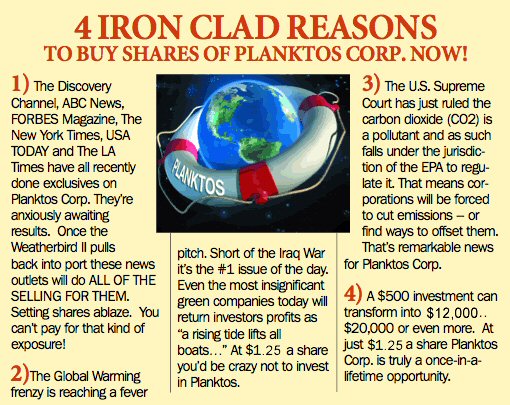
Source: Penny Stock Hunter
But George is starting to get attention from environmental organizations, too, and they're not very enthusiastic about his proposal.
"Planktos is selling the equivalent of global warming snake oil," Nick Berning, press secretary for Friends of the Earth U.S., wrote. "George portrays himself as a champion of the environment, but he's pursuing an iron-dumping project that scientists and environmentalists say threatens the ocean.
"When the Environmental Protection Agency asked him for information about this project, he stonewalled and obfuscated. International science authorities have expressed concern, but George is ignoring his critics and treating the ocean as though it's Planktos' private petri dish rather than a treasure that belongs to us all."
George has begun to plead for understanding and harmony with the environmental groups, as seen at the Grist Web site.
He appeals to his critics to "move beyond infighting and into solidarity in finding, researching, and providing true solutions to the perils ahead."
"It obscures the noble quest for truth," George said.
The Environmental Technology Council, a trade association of commercial environmental firms, expressed grave concerns about Planktos' plans in a May 3 press release.
"Planktos Inc, has announced it is about to dump several tons of tiny particles into the waters around the Galapagos Islands covering an area larger than Puerto Rico," the press release said. "Doing so, they claim, will re-engineer the atmosphere, win them commercial carbon credits and perhaps a shot at the $25 million prize for greenhouse gas reduction put up by Sir Richard Branson."
Elizabeth Bravo of Ecuador-based Acción Ecológica didn't mince words, as stated in the press release: “This is an irresponsible and unpredictable venture by purely profit-driven individuals.”
The promotions for Planktos illustrate the messages presented to investors and mailed out in printed solicitations:

Source: Penny Stock Hunter (archive copy)
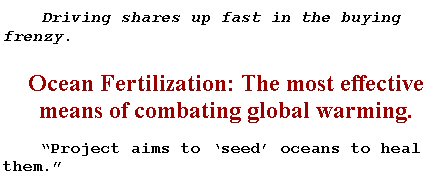
Source: Penny Stock Hunter (archive copy)

Source: Penny Stock Hunter (archive copy)
The International Maritime Organization, the United Nations’ specialized agency with responsibility for the safety and security of shipping and the prevention of marine pollution by ships, discussed several proposals relating to iron fertilization of the oceans to sequester carbon dioxide, during its annual meeting in July in Santiago de Compostela, Spain.
The agency’s report stated, among other things, that although the Intergovernmental Panel on Climate Change agreed that "iron fertilization of the oceans may offer a potential strategy for removing carbon dioxide from the atmosphere by stimulating the growth of phytoplankton and thereby sequestering the carbon dioxide in the form of particulate organic carbon," it also stated that "ocean iron fertilization remains largely speculative, and many of the environmental side effects have yet to be assessed."
The IMO is not to be confused with the International SeaKeepers Society, in which George has been "inducted as a founding member" and whose good reputation George has tried ride. For $50,000, you too can become a founding member.
Some of the other "fringe," according to George, environmental groups that have spoken against him and his plans to dump tons of iron in the ocean are the World Wildlife Fund and Greenpeace.
Recently, Planktos asked Greenpeace to provide Planktos' ship, the Weatherbird II, with an escort up the Potomac river for Planktos' mission into the nation's capital. From my conversation with Kert Davies, research director of Greenpeace U.S., the organization may have some regrets about the association with Planktos.
"Our concern is that, on a scientific level," Davies said, "there is so much unknown about iron fertilization that, if anyone were to proceed with this, we would look at it with great caution and skepticism.
"There is not only the direct ecological consequences of dumping iron in the ocean and screwing up the food chain; there are a lot more possible downstream consequences, as well.
"The basis of their theory is that adding iron in the water will cause a plankton bloom. It's actually not their theory. They are not the first ones to think of it, but they are the first to propose doing this on the scale that they suggest.
"We think there could be very detrimental impacts just on the scale that they are talking about; however, to do it on a scale that would actually make a difference to the climate, you're talking about enormous disruptions of ocean eco-systems.
"You're playing God with the ocean. As an organization, we look at this as another form of dumping in the ocean, and we are against that, naturally.
"Part of our disgust with Planktos is that things like this tend to warp the market.
Although global warming is an emergency and we need to do everything yesterday to solve it, if things like this were to be executed, they provide a get-out-of-jail-free card for polluters, and that's not acceptable. Planktos would be trying to sell credits for putting carbon into the ocean to a polluter."

Source: Penny Stock Hunter (archive copy)

|
"Are you flying across the country but want to offset the carbon dioxide emissions generated by your flight? The solution is simple, send $10 to Planktos."
"On purchase of a Home, Vehicle, or Flight emission reduction, [Planktos] will provide in its records, reasonable proof of actions, taken no later than 120 days after the purchase, intended to offset the promised quantity of carbon emissions. This proof of actions may include certification by a third party."
Source: Planktos Web site, (Archived copy) and the invoice from a carbon credit purchase from Planktos.
|
"There is a giant pool of money out there in the world for ways to capture carbon, Davies said, "which is certainly a good thing, but you can do it in really bad ways or good ways, like growing more trees or planting more crops for biofuels.
"But there are also really stupid things you can do. What they are endeavoring to do on this experiment off the Galapagos is to dump a portion of iron and try to measure systematically how much carbon got sucked up by the biomass.
"Presumably they would later go back and pick up the algae and measure it for its carbon content, and therefore they could predict on a broad scale, if we dump a ton a iron, it can capture "x" amount of carbon dioxide.
"There are billions of dollars on the table with regard to the carbon-credit trading market. It's a really good thing if it's done well. It's all stimulated by the Kyoto protocol.
"It has good aspects, because you can get people who are polluting to pay more for the pollution they create and reward people who are generating clean energy, like from wind power, who can earn carbon credits."
Davies has other concerns, as well, particularly about the underlying science.
"Sure, you might capture carbon dioxide," Davies said, "but what other gasses are given off in the process? Some of them could be actually be greenhouse gasses like nitrous oxide or methane."
George has suggested that sufficient scientific evidence supports his greening plan, but he has yet to deliver the research.
"The world has spent the last 20 years and more than $100 million," George wrote, "developing the science behind the plan."
The validity of this solution is dubious at best and may in fact be a form of greenwashing. (Greenwash - "a term that is used to describe the actions of a company, government, or other organization which advertises positive environmental practices while acting in the opposite way" -- Wikipedia.)
Berning raises another concern.
"Previous studies of such iron fertilization ideas," Berning writes, "have found that most of the carbon that is initially absorbed eventually returns to the atmosphere, and it is very difficult to measure how much carbon remains. These problems, combined with the potential harm to ocean ecosystems, are why we and many others believe that iron fertilization schemes should not be allowed to be sold as carbon offsets."
Berning supports responsible experimentation, subject to regulation and independent scientific oversight, but does not believe that Planktos' iron-dumping program falls into this category.
Even with the generous coverage in Nature, George took umbrage when it labeled his plan “controversial.”
"We fail to see how simply restoring the biosphere-sustaining victims of our excesses can be viewed as anything but obligatory healing or restitution or just merciful common sense," George wrote.
According to an article by Matt Smith in the July 18 SF Weekly, George is determined to go forward with his plans, even if the EPA forbids him to do so, even if the world’s environmentalists oppose it.
If necessary, the article states, George will register his operations offshore or find other ships to "participate" (archive copy) with Planktos.
During a press conference at the National Press Club (archive copy), George answered many questions that raise more questions. He ended with a remark of concern regarding his competitors.
"We live in the world of the high seas," George said. "On the high seas, there are desperadoes out there, and we’re sure that we’ll be victims of them sooner or later."
Folks interested in buying credits from George to offset either their personal contribution to global warming or their company’s emissions had best read the fine print (archive copy) carefully: "The credits are created only when reductions of carbon gas emissions have been verified and validated."
In George's case, that means his projects -- theoretically in the case of the Planktos project -- will contribute to carbon sequestration only when the trees he is planting with the aid of his Hungary "subsidiary" or when his iron fertilization idea "blooms."
If you decide to send your money to Planktos, here's an example of what you can expect in return: a certificate that thanks you, "On behalf of Mother Nature," for your purchase and a letter from Planktos' Ecological Economist Julia Clark which advises you that "carbon dioxide has been retired in our inventory and will contribute to reducing your personal carbon footprint."
One carbon credit is earned when one ton of carbon dioxide has been removed, or offset, from the earth. From what I can tell, a credit can be issued and traded before the underlying carbon offset occurs. Perhaps I'm being cynical, but it seems that a shady operator easily can go to the office supply store, purchase nice-looking certificates, print "carbon credits," then sell them for real cash, and in doing so, provide polluting companies with an alternative to being fined.
An SEC filing on Aug. 10 states, "Planktos' Hungarian subsidiary KlimaFa (translated as "Climate Forest") intends to plant thousands of hectares of new, permanently protected, native forests or 'climate parks' in the national parks system of the European Union and elsewhere."
George is collaborating with Hungarian David Gazdag to manage the KlimaFa project.
Surprisingly, Wikipedia (at publication date) has an entry for George's idea of a "Vatican Climate Forest." The description is strangely worded. It speaks of the "Forest" which is "to be located" in the Bükk National Park of Hungary but says that it "was donated" to the Vatican. Let's see if I get this. The forest, which has not yet been planted, sits on Hungarian soil but was donated to the Vatican.
George's plans beg the following questions:
Because his iron-dumping plan has not materialized, let alone been tested and certified, what is he selling right now besides terrestrial-based credits in Hungary?
Here are some other questions which come to mind. How many trees per year does it take to offset one ton of carbon? How many years does it take a newly planted tree to reach full capacity? If the trees are planted in Hungarian national forests, who owns the rights to these carbon credits? If George, through Gazdag, has contracted with the Hungarian government to sell the carbon credits on a yearly basis, for how long is the contract valid?
The Vatican isn't the only entity that has bought the imaginary credits from George. In March, George announced that the historic Cliff House restaurant in San Francisco became “carbon-neutral” with his help. But carbon emissions are not a one-time event; they are generated continuously. So what does this announcement really mean? Perhaps the Cliff House became "carbon-neutral" for a year. Or maybe it agreed to pay Planktos forever on a yearly basis for carbon offsets.
The Planktos Vatican press release was worded slightly differently. It said the Vatican was "to become" the world's first carbon-neutral sovereign state.
Planting trees is undoubtedly a good thing. However, the whole carbon-credit scene looks very questionable when you examine the big picture, as Fred Foldvary has done in "Carbon Credits: False Absolution."
I was quite confused about this carbon-credit thing and wondered what agency/entity was giving Planktos the authority to issue carbon credits? I asked Berning whom to call.
"Your question is an interesting one," Berning replied. "Congress actually had a hearing into this question in July. Russ George was one of the witnesses called to testify. I think his testimony underscored the need for regulation.
"Unfortunately, in the U.S., the carbon credits market is currently entirely voluntary, without any oversight. So you can go to Russ George's 'store' on his Web site and buy offsets, and there's no way to know how or whether the offsets are actually delivered.
"Congressman Ed Markey, D-Mass., who chaired the hearing, has asked the Federal Trade Commission to look into regulating the carbon offsets market, but no action has yet been taken.
"When Planktos 'offset' the Vatican's emissions, it did so by promising to plant trees. Assuming Planktos follows through with this pledge, it will still take years for these trees to grow. And what's to say they don't burn down?"
The pieces of the puzzle suddenly became clear.
In our society, we are so accustomed to having all of commerce
Regulated that, as consumers, we don't even suspect that someone would or could sell something that doesn't exist, such as plankton-based carbon offsets or a forest of trees that have not been planted. We assume that anybody who puts something up for sale is going to deliver the goods and/or services and, if not, that the person is and will be subject to normal trade regulations and governance.
We are accustomed to the experience that, if you buy stock, the SEC will regulate it, if you buy meat, the FDA will approve it, if you buy real Estate, the California Department of Real Estate will enforce rules governing the transaction.
But in the case of carbon credits being sold in the U.S., no agency or domain provides oversight. So it's a free for all, and one that may be nearly unprecedented in the experience of most consumers.
If the sale of carbon credits is going to work in the U.S., its effectiveness depends completely on the integrity of the seller and the effectiveness of the proposal.
Part Two: Interview with Paul Watson, Founder and President of Sea Shepherd Conservation Society and Founding Director of Greenpeace
Steven Krivit: What do you know about this EPA law that governs what Russ George wants to do and his threats to use another ship besides his Weatherbird II?
Paul Watson: "If the substance they want to dump originates in the U.S., it doesn't matter what flag vessel takes and dumps it, they would be required to obtain a permit from the EPA, but they have not applied for that permit yet."
SK: How did you learn that the substance is originating from the U.S.?
PW: We've been on their boat, we've questioned them, and they told us that it's coming from the U.S.
SK: Do you have any idea why they have chosen the Galapagos? If they were going to test dumping iron-ore in the water, I wonder why they couldn't do it much closer to home.
PW: I really don't know. Planktos did say something about a natural iron ore dust that blows off of the island of Isabella, but when I questioned Raquel Molina, who is the director of the Galapagos National Park Marine Reserve, she said she didn't know what Planktos was talking about, there was no such thing, to her awareness. Then I checked with the Darwin Research Center in the Galapagos, and they didn't know anything about it, either. So really what I think is that it is pretty poor science."
SK: I've seen a press release from you that states that Planktos is "concerned about an intervention from Sea Shepard" and that "they know we are not Greenpeace." What does this mean?
PW: "Well, Greenpeace is a protest organization; we're an intervention organization. Our record speaks for itself. We've sunk nine illegal whaling vessels. We confiscate and destroy millions of dollars of illegal fishing gear every year.
SK: You've sunk nine whaling vessels?
PW: The ships were being convicted of a crime. We were upholding international conservation law. We operate in accordance with the United Nations world charter for nature, which allows for NGOs to uphold international conservation law. And in Ecuador, we have a contractual partnership with the Galapagos National Park and with the Ecuadorian national police
SK: Let's go back to this sinking ships thing. So do you guys carry torpedoes?
PW: Oh, no. Usually, we sink them at dockside with nobody on board by sending in a commando team. We've never caused an injury in our 30 years of operation.
SK: Any final comments?
PW: We're monitoring the situation. We have a full-time patrol boat in the Galapagos so we'll be in a position to intervene if they do go there. As I told Planktos, we're contractually obligated to do everything we can, and as long as the Darwin Research Center, Galapagos National Park and the Ecuadorian Ministry of the Environment are opposed to it and consider it a threat, then we will oppose it.
Part Three: The Wizard of Half Moon Bay
George has attempted to commercialize "cold fusion" since 1992. His efforts helped to fuel the mockery and cynicism from the scientific establishment.
John Huizenga, chemistry and physics professor at the University of Rochester and leader of the 1989 Department of Energy cold fusion review panel, wrote about George's endeavors in his book "Cold Fusion: The Scientific Fiasco of the Century."
"Russell George, president, announced the formation of Clustron Science Corporation, headquartered in Vienna, Virginia. CSC promised to introduce innovative commercial applications in the field of cold fusion. The press release stated that the corporation has made a breakthrough in nuclear science and it will capitalize on the business opportunities in the emerging field of new nuclear science.
"The [Aug. 10, 1992] press release contained a list of sixteen supporters (along with short resumes) of the nucleon cluster model, the foundation of the new Science Corporation. Within days it became known that the names of the so-called supporters had been used without their knowledge. Upon being contacted, eleven of these scientists repudiated the model. Of the remaining five, two could not be contacted and two are non-scientists."
In 2006, George tried to promote another "breakthrough." People reading George's Web site were lured by his extravagant claims of a 1-kw cold fusion reactor. I found nothing to substantiate that claim in the course of my May 10, 2006, investigation of Russ George and D2Fusion.
My resulting perception echoed that of Williams of Northern Sky News.
I, too, felt like Dorothy in the Wizard of Oz, hearing the great and booming voice of the Wizard of Half Moon Bay: "Pay no attention to the man behind the curtain."
At first glance, it is hard to imagine that George's kind manner and can't-we-all-just-get-along good nature and environmentally conscious sales pitch, with precise technical and scientific knowledge, is little more than smoke and mirrors. But by the end of my investigation, that's the way it looked.
I'll give George credit.
He does know his nuclear science remarkably well, perhaps flawlessly.
He is a wizard at arranging publicity, developing creative marketing programs and building impressive-looking Web sites.
His mastery at networking puts him among the experts. In addition to scoring face time with the cardinal, George was apparently -- I have not been able to confirm this -- able to score face time with the secretary of the Navy and other top brass 10 years ago. Assuming that did happen as this document (archive copy) suggests, it doesn't surprise me.
If the meeting never materialized, then I suppose the fine print "prepared for delivery" lets George off the hook from what looks very much like a transcript of something that did happen.
His skills and his superb and delightfully entertaining persona as a public speaker have gained him access to a vast array of reputable institutions as a guest researcher, as shown in his Consulting Services & Laboratory Devices Web page (archive copy), despite the fact that he doesn't have much of a professional background in science or formal credentials.
Readers familiar with George's past may find some of the following details tedious; however, some people may be confused if his myriad mythologies are left to stand.
Let's start with the claim from this Web page that $30,000 will get you a working device, and other discoveries and miracles.
"Our lab devices are ideally suited to serve as practical screening tools enabling researcher and engineers to search for improvements that will enhance these reactions. Such enhancements will provide unparalleled opportunity for discoveries leading directly to scientific breakthrough research and new intellectual property in the energy arena."
Let's read through this carefully. The devices will permit you to search for improvements that will enhance these reactions. Such enhancements will give you the magnificent opportunities described.
Get it? The device as sold won't give you the spectacular results; your improvements to the device, if you should be successful in your search for them, will give you the unparalleled opportunity which will lead to your new intellectual property.
Elsewhere in the Web page, he is listed as "Dr. George." That's the first I'd heard he had a doctoral degree. George tells the press that he has a background as an “environmental scientist," whatever that means.
Further on the page he talks about "Ultrasound Sonofusion Devices." Don't be fooled: That's Roger Stringham's work. George had a minority ownership in a company with Stringham in the early 1990s. George contributed his skills at promotion of Stringham's innovation -- and intellectual property -- until the pair decided to go their separate ways. See the May 10, 2006, issue of New Energy Times for the details.
It is true, as his Web page shows, that George brought a sonofusion device to the laboratory of Yoshiaki Arata, one of the most prestigious physicists in Japan.
Unfortunately, the reactor that George had commissioned to build, independent of Stringham's guidance, was worthless and doomed to failure, according to Stringham.
George says in his Consulting Services & Laboratory Devices Web page that he assisted with a technology transfer from Arata's lab to SRI International.
"This implication is incorrect," Michael McKubre, director of energy research at SRI, wrote. "George was not significantly or constructively involved in the negotiation; scientific or any other aspect of the Arata/Zhang experiment at SRI. Successful replication came about as a direct result of personal discussions between the principal scientists (Professors Arata and Zhang, and Drs. McKubre and Tanzella) and negotiations between their institutions (Osaka University and SRI International) and the sponsor of this work (DARPA).”
To his credit, George probably did open some doors and help pave the way for Arata to look at the idea of Stringham's sonofusion reactor concept. However, because the prototype George built didn't work, it probably ended up in Arata's trash can.
In the course of my recent search for more information on Planktos, I uncovered more information about George's past.
He has had a row of serial attempts to commercialize LENR through a variety of company names, starting with E-Quest Sciences Inc., then E-Quest Technologies, Saturna Technologies Inc., Portal Energies Inc., D2Fusion Inc. and, most recently, D2Fusion Corp.
In 2001, he tried to sell shares of stock in a company he allegedly registered as Portal Energies Inc. A few selected pages of that prospectus are available here.
Some of the statements in the offering appear inconsistent with the facts.
Page 18 of the prospectus, in Section 8.1, states, "The Catalytic Fusion Technology and a device demonstrating this phenomenon are both the inventions of Russ George."
The claim of a demonstration device is suspect. LENR is 18 years old, and no "device" demonstrates a scientifically verified fusion phenomenon, though many experiments demonstrate anomalous effects. So this seems like smoke.
"Catalytic Fusion" is a term, and method, analogous to "cold fusion," developed and originated not by George but by Les Case, of Newfields, N.H. And this seems like mirrors.
The description of the movement of the intellectual property in the prospectus is suspicious.
The prospectus says that George sold this "technology and all rights to the intellectual property ... to a research company, Saturna Technologies Inc." No record was found for this company in the California corporation registry.
The way I read the prospectus, he sold technology that wasn't his to begin with to himself, through Saturna, a virtual or nonexistent "research company."
Then, Portal Energies Inc., another of George's alleged companies, "agreed to purchase the technology and all intellectual property from Saturna Technologies Inc."
Selling an asset from an individual to a (legitimate) company and then to another company is not a crime. But what could possibly be the purpose for such a shell game besides to create the false impression a) that George was in possession of genuine intellectual property and b) that it had some apparent value?
So when would this musical-chairs charade eventually and theoretically pay off for George? The prospectus says that, once Portal stock is sold, $600,000 goes back to Saturna - that is, George, assuming he could open a bank account in the name of Saturna.
Numerous other statements on Pages 19 and 20 concern the alleged technology:
"Russ George ... is a recognized leader in this field. ... George also continues to perform experiments ... at SRI facilities on behalf of Saturna. ... The work proved the fusion process. ... Saturna then developed and engineered experiments on a simple yet effective heat-generating device, which has produced 1 watt of energy continuously for three years. The device is housed at SRI."
The claim of such a device "appears to be completely imaginary," McKubre said.
In the course of my investigation of Saturna, I landed on a report from Infinite Energy from July 1999 talking about George's replication of the Case experiment.
As I was reading this description, I could picture the graph showing the 28-day helium rise from an SRI International experiment. It is one of the most famous graphs in the LENR field; I've reproduced it in my book and in other papers I have written. It was also presented to the Department of Energy in 2004 for review.
The Infinite Energy text makes a clear impression that it's George's work and his paper. The strange language regarding "signatories" also caught my attention.
So I went digging.
I looked for information about this report that George had released. The link provided by Infinite Energy suggested that he had presented the work at the APS conference.
That link was dead, but I found George's representation (archive copy) of the paper on his D2Fusion site. He claims that he presented it at the March 1999 American Physical Society meeting.
In this "paper," he tells the story of how he initiated contact with Les Case (see Wired article) after Case presented his stunning results at the Seventh International Conference on Cold Fusion in Vancouver, B.C.
George gives the impression that he is credited with recognizing Case's phenomenal work and bringing it to SRI. McKubre disputes that.
"As soon as Les was done with his presentation, I went up to him and pummeled him with questions," McKubre said, "though George likely approached Case independently, as well."
Case does not have fond recollections of George's interactions with him.
"He had a lot of ideas," Case said. "But I didn't particularly care for his modus vivende. He was always out promoting, which is OK. There's room for that in the world. But exactly what he was contributing to the process wasn't clear, so I never co-operated with him."
I went to the APS Web site, looking for evidence of George's presentation, but I couldn't find his name in the index.
Then I took a look at the abstract listing for the LENR sessions. I found McKubre and Tanzella's listing of their first report of the Case replication work ("temporal and quantitative correlation between the rates of appearance of excess heat and helium-4").
But George was not listed as a co-author with McKubre and Tanzella and was not among the other LENR presentations listed.
According to McKubre, George took it on himself, against McKubre's instructions, to get up after the formal sessions and make his own presentation of the Case replication results, discussing in greater detail than SRI had authorized.
"I had told him he could not present the details he discussed," McKubre wrote, "until checking, replication and approval was obtained.
"As a visitor to the laboratory, not paid by SRI, George did not feel constrained by the rules of SRI regarding publication of results or treatment of intellectual property owned by others. He was anxious to get the information out. As a legal and ethical obligation to my employer and to my clients who had paid for the work, I could not release the experiment details until I had the approval of both.
"A visitor working in a laboratory is like a visitor invited into your home - in some ways even more so because safety issues are involved. You obey the rules of the land and the rules of the house. You may not pick and choose which rules to respect. Russ made his choices, and I invited him to leave.
"From what I recall, he lost his access privileges at SRI on or before Jan 1, 1999."
A year later, SRI presented a complete report on the Case replication results in May 2000 at Lerici, La Spezia, Italy. The most spectacular and visible result, the helium evolution, is shown on Page 4 of the McKubre et al. paper. In the paper, George, along with 10 other researchers, is credited for his assistance in the research.
McKubre says that George was part of the team that worked on the Case replication at SRI, so naturally he had access to all the data.
"George came with credentials,' McKubre wrote. "He was partners with Stringham, who was an ex-SRI International employee, so we welcomed him into our group."
On Aug. 15, I sent, by e-mail as well as fax, to both McKubre and George, a letter asking for an explanation for the conflicting claims. Both parties, McKubre on behalf of SRI International, and George, on behalf of Saturna, have published references to the same scientific research claiming exclusive ownership.
In McKubre's paper, he makes the assertion that the work in question, showing a correlated heat and helium-4 evolution, is an SRI project.
In one, two and three reports, George has made the assertion that the work in question, showing a correlated heat and helium-4 evolution is his, a Saturna project.
McKubre responded, "For the record, the effort that supported the results disclosed in the attached documents and citations was wholly an SRI project, performed under contract from DARPA at SRI, with SRI project leadership and supervision. All publications resulting from all such projects are subject to both SRI management and client review. After checking, replication and review, a preliminary report of the results was made by me at the March 1999 meeting of the APS. I disclosed the data more fully and in broader context at ICCF8 in 2000 and again in 2004 in a paper presented to the Department of Energy.
“Mr. George participated for a short time in the SRI/DARPA Case replication experiment as a laboratory visiting scientist. He contributed to the experiment design, and to the helium mass spectrometry under the instruction and supervision of Francis Tanzella; George's participation is acknowledged in the paper. He was not and is not authorized to report on this work independently of SRI. I had no knowledge of the existence of Saturna Technologies at the time the work was done, and no aspect of the SRI work was performed under the auspices of Saturna."
George failed to respond to New Energy Times' request.
Part Four: Russ George, Medical Foundation Director
|
In my search for more information on Saturna, I turned up some other interesting information.
George apparently attempted an earlier version of Planktos under the name of Carbon Corp. USA.
And, according to this Web archive, George also founded the IgA Nephropathy Foundation. An active site at this (archive) Web location explains how to donate nearly anything you wish to support the foundation's research efforts.
|
Part Five: Solar Shuffles D2Fusion and Planktos Assets
The corporate shell game evident with Saturna in 2001 took a similar turn when George "sold" his current technology, an asset of D2Fusion Inc., to the publicly traded Solar Energy Ltd. in 2005, along with Planktos Inc.
In June, Solar announced that it would allow D2Fusion Inc. and Planktos Inc. to be "acquired via a reverse take over by two separate public companies." The original press release from Business Wire has been removed, but here is an archive copy.
The press release states that Planktos Inc. will become Planktos Corp., Enwin Resources Inc. will "acquire" D2Fusion Inc. and Enwin will change its name to D2Fusion Corp.
In short, Solar sold D2Fusion Inc. and Planktos Inc. to D2Fusion Corp. and Planktos Corp.
But Solar retained 45 million and 30 million shares of D2Fusion Corp. and Planktos Corp., respectively, thereby still still owning a controlling interest in them.
The net effect is that they create the appearance of something new, something lucrative to lure new investors, and a greater ability to promote Planktos Corp., separate from their other companies, as the billion dollar carbon-trading market begins to blossom.
In 2005, George told me that he had "sold" D2Fusion Inc. for $2 million. I believed that this was real money, and I published the wonderful news of his "sale," unaware that the $2 million was only a promise.
A LENR scientist who spoke to George's financial backer, Nelson Skalbania, later told me that Skalbania assured him that he had $2 million of real funds available for D2Fusion.
That's the same Skalbania who was sentenced to jail time for an investment-related misappropriation of investor funds. Such goings-on don't seem out of character for Skalbania, according to an article by David Baines of the Vancouver Sun, reproduced in this blog entry.
During the early promotion of George's new partnership with Skalbania and Solar, George went around to the researchers in the LENR community and got some of them to join with him. Others declined.
LENR researchers have been on a starvation budget since the field suffered disrepute 18 years ago, though the stigma is slowly lifting, as evidenced in recent press reports from Nature, Chemistry World, Chemical & Engineering News and the Chicago Tribune and even renewed interest from the U.S. government.
Thus, the utilization of underemployed talent has been relatively easy, as George apparently found. The co-discoverer of "cold fusion," Martin Fleischmann, ex-communicated from science academia and without a laboratory to work in, was eager to consider George's solicitation for him to work with D2Fusion.
Some time later, when I informed Fleischmann that George had represented his relationship with D2Fusion in D2Fusion's press release as a new member of the company, Fleischmann advised me that, no, he was not employed or even on contract with D2Fusion, that he had only a discussion of possible intent with George.
Fleischmann, long retired and living in the U.K. with his wife, Sheila Fleischmann, isn't part of the online, cyberworld and had no idea how George had represented him in the press release until I read him some excerpts.
"They're blowing this whole thing up into a great big boondoggle," Fleischmann responded.
Issue #16 of New Energy Times goes into more details of George's activities with the LENR community, though recent information that George filed with the Securities and Exchange Commission displays further, bold inconsistencies.
For example, a 10KSB filing from Solar Energy Ltd. on April 15, 2007, states, "Mr. George’s successful experimental prototypes have been tested at the Los Alamos National Laboratory and Stanford Research Institute."
According to SRI, that claim doesn't hold water.
"The information in this SEC 10K filing is not accurate," Ellie Javadi, SRI corporate and marketing communications director, wrote. "The filing incorrectly implies that SRI International has endorsed Mr. George's work and/or prototype. SRI has not endorsed Mr. George's work or his prototype."
The word from Los Alamos National Laboratory provides no additional support.
"It may be more of a matter of semantics,” Todd A. Hanson, senior adviser for science communications, said, "because Mr. George did test at least one prototype in the city of Los Alamos, just not at Los Alamos National Laboratory.
"According to Dale Tuggle, a Los Alamos scientist who has indeed worked as a consultant for Mr. George, they did test a prototype of George's at a private laboratory in Los Alamos. The tests were done by current or retired Los Alamos National Laboratory scientists and, I gather, were inconclusive. I am quite certain our laboratory, as a public entity, would not and could not officially endorse Mr. George's work and/or prototype, irregardless of its merit or functionality."
Part Six: The Amazing Russ George
One of George's other talents is document fabrication. Before my first investigation on D2Fusion, George had displayed a Web page showing what appeared to be the cover page of an EPRI technical report. The actual report cover pages look like this. George's version looks like this, which displays multiple inconsistencies with the facts.
As I fathom the myriad brilliant George representations, I can't help but remember the 2002 movie "Catch Me If You Can," starring Leonardo DiCaprio and Christopher Walken.
DiCaprio's character, Frank Abignale Jr., is a young man who receives his first checkbook from his father as a gift and doesn't quite get that you have to put money into the account before you write the checks.
When Abignale finds that his personal checks no longer are accepted, he learns how to fabricate business checks and later develops his skills in forgery.
He cons his way into being a co-pilot for a major U.S. airline, getting free cross-country trips and more. At one point, he also figures that a forged medical school certificate is just as effective as a real one for getting a job in a hospital.
George also writes that he "has had a long-standing relationship with both Electric Power Research Institute and SRI." Certainly, the SRI relationship is no longer standing. I don't know the status of his relationship with EPRI.
Hs associate, Tom Passell, a retired Electric Power Research Institute EPRI program manager, once saw things from
an enlightened
perspective, as he says in Gene Mallove's film Cold Fusion: Fire from Water.
"The search for money in research is a very big thing," Passell said, "and it sometimes takes precedence over the search for what we would call pure truth."
Judging by George's increased boldness, he apparently has come to believe more strongly in his methods. He appears unapologetic about his way of doing things. He wrote in a July 2005 e-mail and once (archive copy) had on his Web site the following quote from Woody Guthrie: "If you steal from one person, they call that plagiarism. I steal from everyone; they call that research!"
Perhaps George will strike it rich someday, but I doubt it will be in science. Perhaps he'll sell the rights to his life story.
________________________________________________________________________________
Support New Energy Times(tm)
New Energy Times (tm) is a project of New Energy Institute, an independent 501(c)(3) nonprofit corporation that provides information and educational services to help bring about the clean-energy revolution.
The New Energy Times (tm) newsletter, Web site, and documentary projects are made possible by the generous contributions of our sponsors and supporters.
__________________________________________________________________________________
Administrative
Copyright 2007 New Energy Times (tm)
Publication, in print or electronically, is not permitted without express written permission.
|

